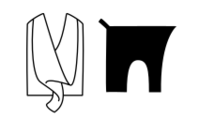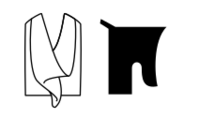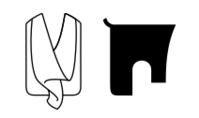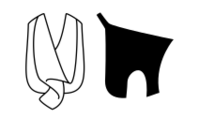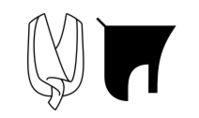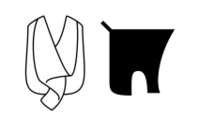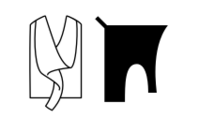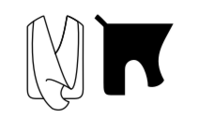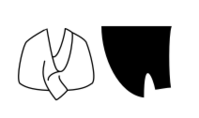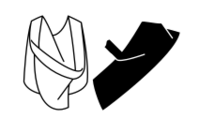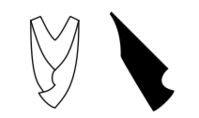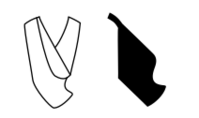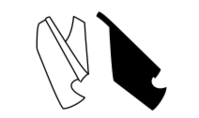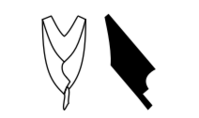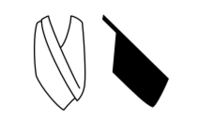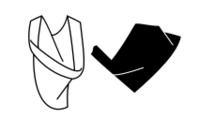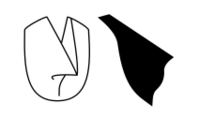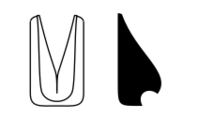Astronomy:Groves classification system
The Groves Classification is a numbering system to enable the shape of any academic gown or hood to be easily described and identified. It was devised by Nicholas Groves to establish a common terminology for hoods and gown to remedy the situation of individual universities using differing terms to describe the same item. As such it is used in same manner as an heraldic blazon whereby a textual description enables a coat of arms to be drawn. The system was first described in the Burgon Society's annual in 2001 and adopted as standard by robe makers and scholars of academic dress.[1]
Classes
| Cape | Cowl | Liripipe | 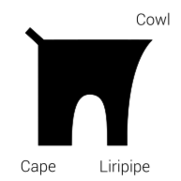
| |
| Full | ||||
| Simple | ||||
| Aberdeen |
The original Groves Classification included a standardization for shapes and patterns of hoods and gowns worn by graduates and undergraduates. Further information was given regarding the use of different fabrics and standardization of colors, but the focus was placed on gowns and hoods which are explained further below.[1]
The Classification undergoes periodic revision as new hood and gown patterns emerge.
Hoods
Hoods in the Classification are divided into three different types as summarised in the table below. Unlike the gowns and robes, these are based on the shape of the hood rather than the degrees for which they are worn.
- [f] full shape hoods are those that have a cape, a cowl and a liripipe.
- [s] simple shape hoods have only a cowl and a liripipe.
- [a] Aberdeen shape hoods have only a cape and a vestigial cowl.
Gowns
Gowns in the Groves system are divided into three classes. These generally follow the shapes associated with each different academic degree in the British educational system.
- [b] bachelor's gowns typically have large open sleeves
- [m] master's gowns typically have long closed sleeves with armhole at elbow level
- [d] doctor's robes vary in shape widely between institutions and are all classed as [d].
Bachelors
| Code | Example | Notes |
|---|---|---|
| Bachelors gowns | ||
| [b1] | Basic bachelor | plain open sleeves, point reaching knee |
| [b2] | Cambridge BA | sleeve has slit in foream seam |
| [b3] | Cambridge MB | front of sleeve has foldback and cord and button |
| [b4] | London BA | front of sleeve is pleated and held by cord and button |
| [b5] | Durham BA | lower 8" of forearm seam left open, and held by button and loop |
| [b6] | Wales BA | lower 6" of forearm seam left open and folded back, held by 2 buttons, with third button on seam in middle |
| [b7] | Bath BA | as [b5], but with button at top of slit |
| [b8] | Oxford BA | as [b1], but sleeves reach hem of gown |
| [b9] | Belfast BA | bell sleeve, pleated as [b4] |
| [b10] | Dublin BA | as [b1], but sleeves much smaller |
| [b11] | Reading BA | as [b2], but sleeve point is rounded off |
| [b12] | Sussex BA | bag sleeve with small armhole |
Masters
| Sleeve pattern | 
|

|

|

|

|

|

|

|

|
| Degree | Oxford MA | Cambridge MA | Dublin MA | Wales MA | London MA | Victoria MA | Lampeter BD | Leicester MA | Bristol MA |
| Code number | [m1] | [m2] | [m3] | [m4] | [m5] | [m6] | [m7] | [m8] | [m9] |
|---|---|---|---|---|---|---|---|---|---|

|

|

|

|

|

|

|

|

| |
| Basic Master | Lancaster MA | Scottish MA | Not used | Open | Warwick MA | Bath MA | Sussex MA | Manchester MA | King's MA |
| [m10] | [m11] | [m12] | [m13] | [m14] | [m15] | [m16] | [m17] | [m18] | [m19] |
Doctors
| Code | Example | Notes |
|---|---|---|
| Doctors/Special gowns | ||
| [d1] | Cambridge doctors | wide open sleeves, similar to [b1], with the wrist turned back and held with a cord and button |
| [d2] | Oxford doctors | bell sleeves |
| [d3] | Cambridge MusD | small bell sleeves with cuff |
| [d4] | Cambridge LL.D undress | flap-collar (QC's) gown |
| [d5] | Oxford convocation habit | sleeveless habit closed with two buttons at the front |
| [d6] | Sussex doctors | MA-style sleeve with vertical slit, base hollowed into B shape |
| [d7] | Aston | narrow sleeves |
| [d8] | Cambridge DD undress | bell sleeves gathered at wrist |
Headwear
| Code | Example | Notes |
|---|---|---|
| [h1] | Mortarboard | a square board attached to a skull cap, often with a button and tassel |
| [h2] | Tudor bonnet | a round soft hat with brim, often with a cord and tassels |
| [h3] | John Knox cap | a square soft cap |
| [h4] | Bishop Andrewes cap | like [h1] but soft and with a silk tuff in lieu of button and tassel |
| [h5] | Oxford ladies' cap | a soft square cap with a flap at the back and held up with two buttons |
| [h6] | Sussex pileus | a round cylindrical cap with a covered button on the top |
| [h7] | Leicester doctoral cap | a modified biretta |
| [h8] | UEA BA | a skull cap with upturned brim (no longer used) |
| [h9] | UEA MA | a skull cap with a triangular structure on top (no longer used) |
Changes
The Groves classification system was first published in 2001. Since that time, it has been adapted and changed to include newly devised academic dress and revisions of existing schemes.[1] The Burgon Society maintains a comprehensive listing of system shapes on its website. In addition to those included above, the current list classifies undergraduate gowns in use throughout the United Kingdom and academic headwear.[2]
References
- ↑ 1.0 1.1 1.2 Groves, Nicholas (2001), "Towards a Standard Terminology for Describing Academic Dress", The Burgon Society Annual 1: 9–12, http://www.burgon.org.uk/society/library/trans/annual2001.pdf.
- ↑ "The Design of Academical Dress". The Burgon Society. http://www.burgon.org.uk/design/groves.php.
 |
